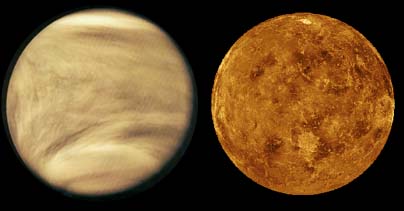
Venus' cloudtops in UV (left) and Venus' surface imaged with radar (right).
Venus, Earth, and Mars are approximately at the same distance from the Sun. This means they formed out of the same material and had approximately the same initial temperatures 4.6 billion years ago. Long ago these three planets probably had moderate enough temperatures suitable for life. However, Venus is now much too hot for life and Mars is too cold for life. What happened to these two planets and why are they so different from the comparative paradise here on Earth? This section explores these three planets in more detail in order to answer this important question and what it might say for the future of the Earth.

Venus is about 95% the size of the Earth and has 82% of the Earth's mass. Like the Earth, Venus has a rocky crust and iron-nickel core. But the similarities stop there. Venus has a thick atmosphere made of 96% carbon dioxide (CO2), 3.5% nitrogen (N2), and 0.5% other gases. Venus' ever-present clouds are made of sulfuric acid droplets between 45 and 66 km above the surface. It is those clouds that continually block our view of Venus' surface, so we must use radar imaging (bouncing radio waves off its hard surface) to "see through" the clouds. Between the equator and about 55 degrees latitude the lower clouds in Venus' atmosphere move at about 210 km/h and the uppermost clouds move much faster at 370 km/h. Near the poles, the winds are weaker and do not change with height because of the huge hurricane-like vortex that exists there. At the center of the vortex, there are no winds. Close to the surface, the winds are also essentially non-existent.
At Venus' surface, the air pressure is 92 times the Earth's surface atmospheric pressure. Venus' surface atmospheric pressure is the same as what you would feel if you were 1 kilometer below the ocean surface on the Earth. The deepest free-divers can get down to around 160 meters (and divers breathing special mixtures of gases can get down to 730 meters). If you want to send someone to Venus, that person would need to be in something like a diving bell.
Surface of Venus from the Venera 13 lander on March 3, 1982. Note the flat basaltic rocks that are still sharp and un-eroded. The spacecraft edge is at the bottom right corner of the image. The view extends out to the horizon at the top left corner of the image. The shiny piece on the middle right is the camera cover. Venera 13 lasted for 127 minutes before the extreme heat overcame the electronics.
Besides being in a diving bell, the Venus explorer would also need a very powerful cooling system: the surface temperature is 737 K (= 477° C)! This is hot enough to melt lead and is over twice as hot as it would be if Venus did not have an atmosphere. Why does Venus have such a thick atmosphere and why is it so hot on its surface? Venus is so hot because of a huge greenhouse effect that prevents heat from escaping to space. On Venus, the super-abundance of CO2 in its atmosphere is responsible for the huge greenhouse effect. Why is Venus' CO2 all in its atmosphere while most of the Earth's CO2 is locked up in its sediments? Earth has some 35 to 50 entire Earth atmospheres worth of carbon dioxide in the form of carbonates. Venus' greenhouse effect probably started from the presence of a lot of water vapor, but Venus is now a very dry place.
Venus was originally cooler than what it is now and it had a greater abundance of water several billion years ago. Also, most of its carbon dioxide was locked up in the rocks. Through a process called a runaway greenhouse, Venus heated up to its present blistering hot level. Because Venus was slightly closer to the Sun than the Earth, its water never liquified and remained in the atmosphere to start the greenhouse heating. As Venus heated up, some of the carbon dioxide in the rocks was "baked out." The increase of atmospheric carbon dioxide enhanced the greenhouse heating. That baked more carbon dioxide out of the rocks (as well as any water) and a runaway positive feedback loop process occurred. This positive feedback loop occurred several hundred million to a few billion years ago so Venus has been very hot for that length of time.
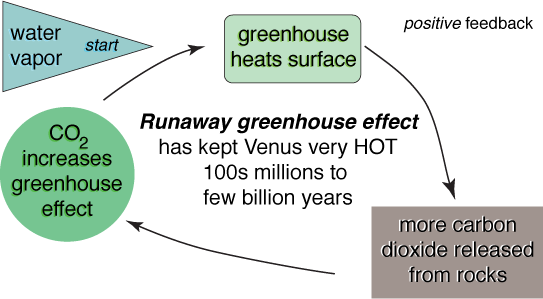
The loss of water from the rocks means that Venus' rocks are harder than the rocks of Earth and its lithosphere is now probably too thick and hard and its asthenosphere is too poorly lubricated for plate tectonics to occur. The water Venus originally had is now gone because of a process called dissociation.
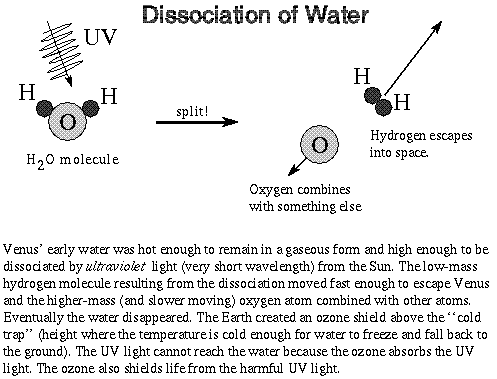
Venus' water was always in the gaseous form and could reach high enough in the atmosphere for ultraviolet light from the Sun to hit it. Ultraviolet light is energetic enough to break apart, or dissociate, water molecules into hydrogen and oxygen. The very light hydrogen atoms were able to escape into space and the heavier oxygen atoms combined with other atoms. Venus' water was eventually zapped away. The Earth's ozone layer prevents the same thing from happening to the water here.
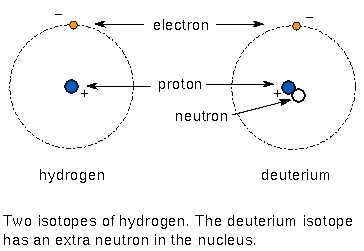
Ordinary hydrogen has only one proton in the nucleus, while the isotope deuterium has one proton + one neutron. Therefore, deuterium is about twice as heavy as ordinary hydrogen and will stay closer to the surface on average. Gases higher up in the atmosphere are more likely to escape to space than those close to the surface.
On Earth the ratio of ordinary hydrogen to deuterium (H/D) is 1000 to 1, while on Venus the proportion of deuterium is about ten times greater---the H/D ratio is 100 to 1. The H/D ratio on Venus and Earth are assumed to have been originally the same, so something caused the very light hydrogen isotopes on Venus to preferentially disappear. An easy explanation for it is the ultraviolet dissociation of water.
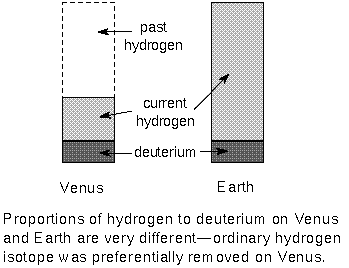
A summary flowchart of what happened on Venus is given on the Earth-Venus-Mars summary page. Water vapor started the greenhouse heating. Carbon dioxide was baked out of the rocks, further aggravating the greenhouse effect. A runaway greenhouse started. The end result was all of the carbon dioxide in the atmosphere and the water dissociated away. The flowchart on the Earth-Venus-Mars page up to the last arrow occurred several hundred million to a few billion years ago. The diamond at the end describes the current state: CO2 maintains the extremely hot temperature.
|
Magellan radar image of three large craters in the northwestern portion of Lavinia Planitia that is in the southern hemisphere of Venus. Howe Crater in the foreground is 37.3 km in diameter. Danilova Crater to the upper left of Howe is 47.6 km in diameter. Aglaonice at the right is 62.7 km in diameter. |
Gula Mons stands 3 kilometers above the rest of Eistla Regio. Lava flows extend for hundreds of kilometers across the fractured plains. The Venus Express spacecraft has seen evidence (reported April 2010) that some volcanoes at least were active very recently and perhaps still are. |
There is a bit of uncertainty in how long ago the runaway process happened because of what happened to Venus' entire surface about 750 million years ago. Venus has the same number of craters/area all over its surface and when you compare the number of large craters/area on Venus with other places in our solar system, you derive an age of 750 million years (give or take a few tens of millions of years) for all of the surface of Venus. It appears that Venus underwent a global repaving event involving a large amount of tectonics or volcanism or combination thereof. That activity would have vaporized any carbonates locked up in the rocks adding to any greenhouse effect already going on. The global repaving event would have also removed whatever water might have been in the mineral matrix of the rocks making the rocks much harder than before. This is one reason why the rocks around craters are much more jagged and sharp than they would be if they were Earth rocks (lack of erosion is another). The removal of the water from the rocks would have prevented any further plate tectonic activity if there was any to begin with. Venus is much too hot and dry now for plate tectonics to work. Venus does have volcanism occurring today as a result of hot magma plumes reaching the surface at some of its shield volcanoes.
It may be that the loss of water led to the shutting down of plate tectonics and the steady build-up of heat in the interior because it could not be released like what happens with the Earth through plate tectonics. In this view, the global repaving would happen when the interior heat builds up to a critical point. Could Venus have been a much nicer place before the global repaving event, how much did the global repaving event contribute to the runaway process, and whether or not Venus has had multiple global repaving events are three questions for further research.
![]() Go back to previous section --
Go back to previous section --
![]() Go to next section
Go to next section
last updated: March 23, 2020